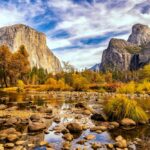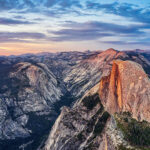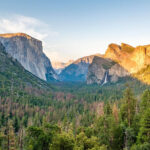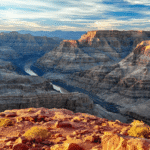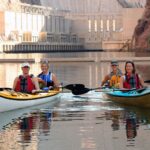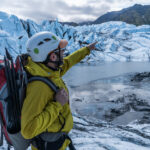Are you planning a trip to Yosemite National Park, but aren’t sure of the best time to travel? Fear not, for every season in Yosemite is exceptional! Whether you’re chasing waterfalls, wildflowers, or snow-covered peaks, Yosemite has something incredible to offer year-round. Each season brings its own personality, suited to every type of traveler.
Here at Incredible Adventures, we love visiting Yosemite in both summer and winter as part of our Yosemite National Park Tours. In this guide, we break down Yosemite’s seasons, including weather, activities, and key travel tips to help you discover the best time to visit Yosemite based on your interests and travel style.
Keep reading below for our insights, and feel free to contact us with any questions about our tours!
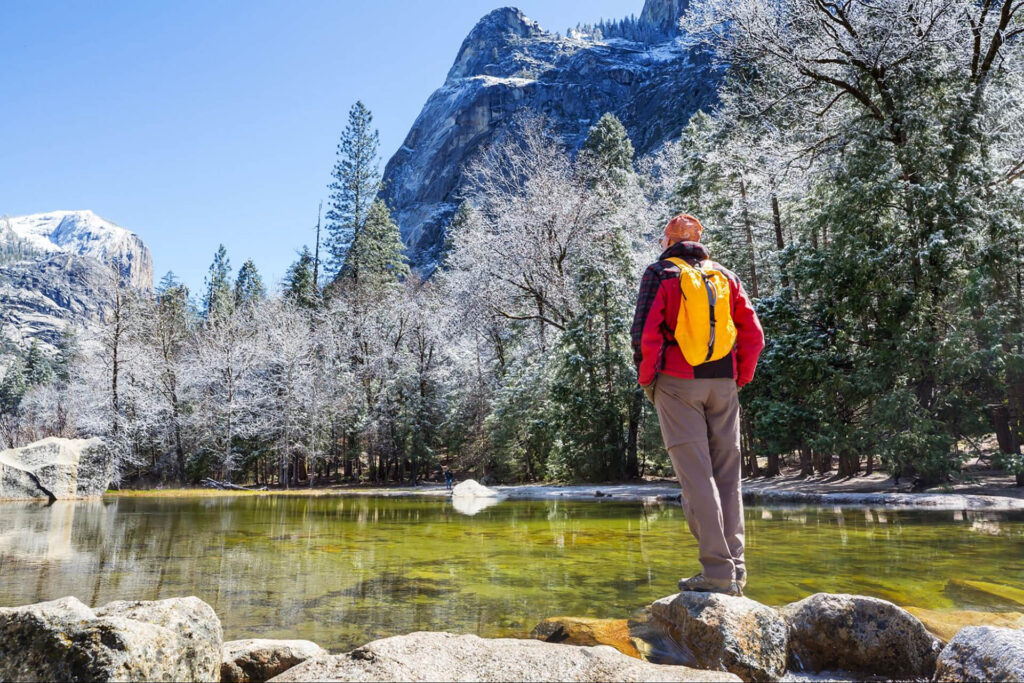
Summer in Yosemite (June-August)

Summer is the most popular time to visit Yosemite National Park, and for good reason. With all park roads open and trails fully accessible, this is the best season for exploring Yosemite in its entirety. Long daylight hours and dry, sunny weather make it ideal for hiking, camping, and water activities.
Summer Weather in Yosemite
Temperatures in Yosemite vary depending on elevation, but are generally warm in summer. Daytime temperatures in Yosemite Valley average around 80°F, but can reach as high as 100°F. Rainfall is scarce, but there may be the occasional afternoon thunderstorm. Nights are cool and comfortable, perfect for a campfire.
Yosemite Summer Highlights
The summer months in Yosemite are idyllic for adventures and family-friendly activities. And with the park entirely accessible, it’s ripe for exploration! Embark on hikes to iconic attractions like Yosemite Falls and Sentinel Falls, or walk among the giant sequoias of Mariposa Grove. Alternatively, give your feet a break and go cycling or horseback riding!
Water activities are popular during this time, with fishing, swimming, and boating all on the table. Go rafting down the Merced River and admire the stunning scenery from a unique perspective. The Tuolumne Meadows are also easily accessible during this time, with open roads and public transportation available.
Tips for Visiting Yosemite in Summer
Summer is the busiest season in Yosemite, so be prepared for crowds and traffic. Make sure to book your accommodation and reservations well in advance. To make the most of your time here, start your adventures early so you not only miss the crowds but also avoid the heat.
If you want to explore Yosemite without the stress of planning, our Yosemite Summer Guided Overnight Lodging Tour includes all of your transportation and accommodation, as well as an expert guide to accompany you!
Fall in Yosemite (September-November)

Fall is a favorite among seasoned Yosemite travelers thanks to its crisp air, golden foliage, and reduced crowds. As the temperatures cool, the park takes on a different kind of beauty that’s ideal for photographers and those seeking a quieter retreat.
Fall Weather in Yosemite
September still feels like summer in many ways, but temperatures drop in October and November. With highs around 55°F and lows of 35°F, you can expect variable weather conditions with the possibility of rain and snow. The weather remains generally dry through October, making it an excellent time for hiking longer trails.
Yosemite Fall Highlights
Fall is also a prime season for photographers, as the foliage changes color and the light softens. The cooler weather and fewer crowds make this an excellent time for hitting longer hiking trails or trying your hand at rock climbing. Wildlife, such as deer and birds, may also become more active and are more easily spotted. Learn more with our blog about Why You Should Visit Yosemite in the Off Season!
Tips for Visiting Yosemite in Fall
It’s important to keep an eye on weather forecasts this time of year, as Tioga Road and Glacier Point Road may close temporarily or permanently with significant snowfall. Remember to pack layered clothing, as you will deal with temperature fluctuations between day and night.
Winter in Yosemite (December-February)

Winter transforms Yosemite into a snow-covered wonderland, ideal for those who appreciate solitude and the quiet beauty of nature. However, it’s still a time of recreation, as you can enjoy winter sports like skiing, snowboarding, and ice skating!
Winter Weather in Yosemite
Average temperatures in winter are around 53°F, and snowfall is common, especially above the valley floor. Tioga Road will be closed as a result, but Yosemite Valley and Wawona remain accessible by car. While you can expect snowy, cold weather, you can also look forward to sunny days!
Yosemite Winter Highlights
The winter season brings a new range of activities, including snowshoeing, cross-country skiing, and snowboarding. The Badger Pass Ski Area operates as Yosemite’s official winter sports hub and is also home to the oldest downhill ski area in California! If you want to strap on some skates, you can head to the Curry Village Ice Rink.
Hiking is still a popular activity during the winter, and you may even still spot some wildlife. Of course, the magical scenery is perfect for photographers too. If you’re looking for more ideas on what to do this season, read our guide on What There is To Do in Yosemite in Winter.
Tips for Visiting Yosemite in Winter
Driving in Yosemite in winter requires preparation. Tire chains may be necessary, and it’s important to check road conditions before entering the park. If you’re concerned about navigating the park in winter, consider joining our Yosemite Winter Guided Overnight Lodging Tour, where we take care of everything for you!
Spring in Yosemite (March-May)
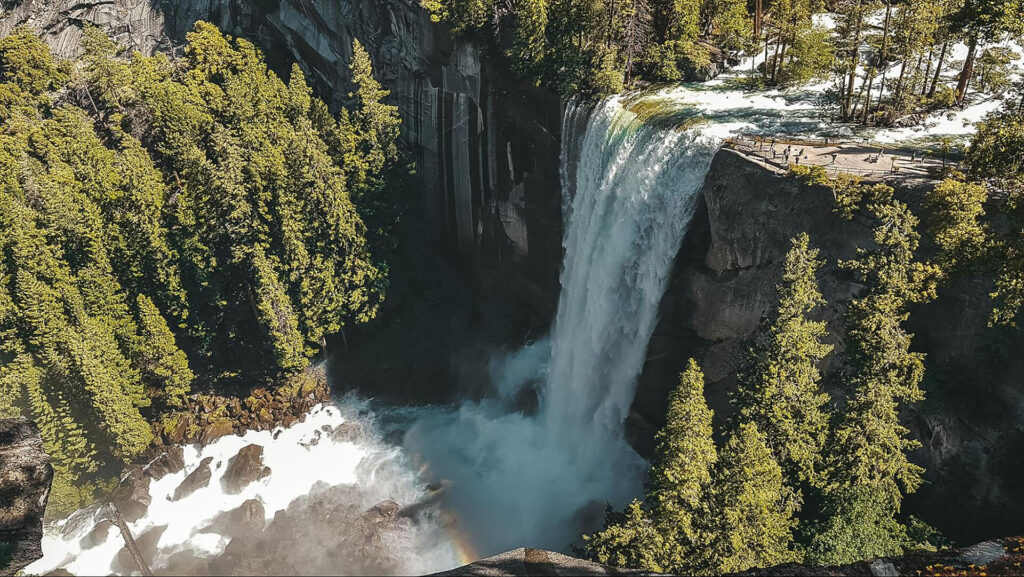
Spring marks the revival of Yosemite’s landscapes as snowmelt begins to awaken the valley. This is the season when Yosemite’s waterfalls are at their most powerful, fueled by melting snow. It’s also when the park’s lower elevations burst into bloom, with colorful displays of wildflowers along the trails and rivers.
Spring Weather in Yosemite
The weather during spring can be unpredictable, especially in the early months. While temperatures warm up, snow is still possible at higher elevations. High temperatures average around 70°F, while you can experience lows of around 40°F. You may also still experience the occasional shower.
Yosemite Spring Highlights
Spring is waterfall season in Yosemite, with the cascades roaring to life. Peak fall is usually in May, when you can see Yosemite Falls, Sentinel Falls, Bridalveil Fall, and more at their most abundant. But if you want to avoid the crowds, visit lesser-known waterfalls like Chilnualna, one of our Top 5 Hidden Gems in Yosemite Beyond the Valley Floor!
By late May, you can also see Yosemite Valley bursting with color as flora such as dogwood, lupines, and poppies begin to bloom, making this an ideal time for photography as well. Hiking is also possible during spring, but prepare to encounter ice and snow and wear good shoes. Wildlife also returns, with bears emerging from their long hibernation and deer grazing in the meadows.
Tips for Visiting Yosemite in Spring
If you’re planning a spring visit, layers are essential. Arriving early in the day is also a good idea, especially on weekends, as spring draws many visitors eager to see the waterfalls at their peak. Keep in mind that Tioga and Glacier Point Roads may remain closed until May or June as a result of snow.
Discover Yosemite with Incredible Adventures
So, what’s the best time to visit Yosemite? It truly depends on what you’re looking for. Come in spring if you want to see thundering waterfalls and blooming wildflowers. Visit in summer for full park access and classic outdoor adventures. Choose fall for vibrant foliage and fewer crowds. And embrace winter if you’re after peace, snow, and a different side of Yosemite.
For those traveling from the San Francisco Bay Area, our guided Yosemite National Park Tours are a convenient and stress-free way to experience the park. Let our experts handle the driving and logistics while you soak in the scenery and enjoy your adventure! If you have any questions about trips, feel free to contact us.

